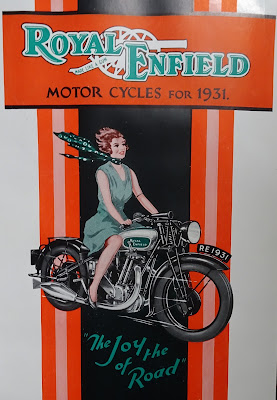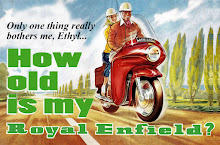 |
| We know the model of motorcycle, but not the name of the model. |
We don't know her name, but I think we have an appropriate nickname for her: "The Lady on the Lawn."
Her nickname was coined by Bob Murdoch, archivist of the Royal Enfield Owners Club (UK), who sent the evidence to me in an email.
"See attached, what I think is the artwork made from the photo session of the lady on the lawn, 1931," he wrote.
 |
| The motorcycle is rendered exactly; the rider not so much. |
I had speculated that a particular photo shoot for the 1931 Royal Enfields had resulted in some racy illustrations the company used in its advertisements.
I first noticed the woman model, dressed in white and seated on a powerful Royal Enfield in photographs in the Hitchcocks Motorcycles archive of factory photographs.
The photos themselves weren't used in the advertisements of that day: they were traced for line drawings that could be colorized as needed, and even improved by artists.
In the course of being turned into art the woman model could be made to look prettier, or, at least, more comfortable on the motorcycle.
Her perceived emotions could be carried to extremes. I say the illustrations were "racy" because some showed the woman riding at breakneck speed, her scarf flying in the wind.
 |
| From the same year, but possibly from a different photo shoot, "The Joy of the Road" artwork was labelled "Cover for Leaflet." |
The Hitchcocks archive has no doubt what kind of Royal Enfield motorcycle the Lady on the Lawn is riding:
It is "a 346cc Royal Enfield Model CO. This RE model was for the 1931 season and features OHV and a total loss oil pump mounted externally on the timing cover."
But who was the girl? Could she really even ride a motorcycle?
Possibly she was someone already in the employ of Royal Enfield. Many women worked at the factory.
Barbara Seviour was a secretary there during the war years, and a bit afterwards.
She told historian Anne Bradford, author of "Royal Enfield, The Story of the Company and the People Who Made It Great," that she was sometimes asked to pose.
She went on to say:
"I would hasten to add that I was used as a model not so much for my looks but for the single fact that, as Tony Wilson-Jones' secretary, I was on hand."
That was probably the right attitude for an executive secretary to take, but the book includes an example of her posing, in the 1941 "It's a Lovely Day Tomorrow" ad.
(The title was taken from the Irving Berlin song famously recorded by Vera Lynn to lift British morale in the Blitz.)
By this time actual photos were being used, not illustrations drawn from them, so there is no hiding the fact that she made a pretty passenger on the back of a Royal Enfield motorcycle.
 |
| Executive secretary Barbara Seviour posed for Royal Enfield and country in morale boosting 1941 advertisement. (Rockers Bike Ads) |






























No comments:
Post a Comment